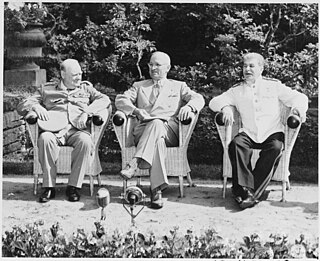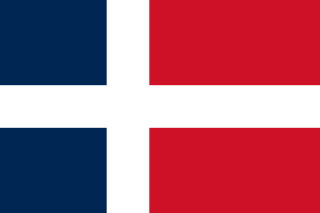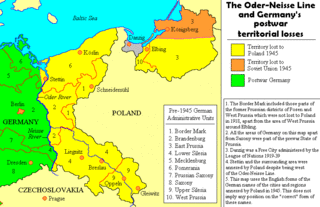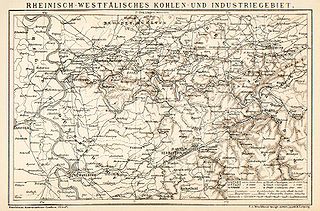
Konrad Hermann Joseph Adenauer was a German statesman who served as the first chancellor of the Federal Republic of Germany from 1949 to 1963. From 1946 to 1966, he was the first leader of the Christian Democratic Union (CDU), a Christian-democratic party he co-founded, which became the dominant force in the country under his leadership.

The Potsdam Conference was held at Potsdam in the Soviet occupation zone from July 17 to August 2, 1945, to allow the three leading Allies to plan the postwar peace, while avoiding the mistakes of the Paris Peace Conference of 1919. The participants were the Soviet Union, the United Kingdom, and the United States. They were represented respectively by General Secretary Joseph Stalin, Prime Ministers Winston Churchill and Clement Attlee, and President Harry S. Truman. They gathered to decide how to administer Germany, which had agreed to an unconditional surrender nine weeks earlier. The goals of the conference also included establishing the postwar order, solving issues on the peace treaty, and countering the effects of the war.

The Potsdam Agreement was the agreement between three of the Allies of World War II: the United Kingdom, the United States, and the Soviet Union on 1 August 1945. A product of the Potsdam Conference, it concerned the military occupation and reconstruction of Germany, its border, and the entire European Theatre of War territory. It also addressed Germany's demilitarisation, reparations, the prosecution of war criminals and the mass expulsion of ethnic Germans from various parts of Europe. France was not invited in the conference but formally still one of powers occupying Germany.

The history of Germany from 1945–1990 spans the period following World War II, from the Berlin Declaration marking the Allied-occupied period in Germany on 5 June 1945 to German reunification on 3 October 1990.
Following the termination of hostilities in World War II, the Allies were in control of the defeated Axis countries. Anticipating the defeat of Germany and Japan, they had already set up the European Advisory Commission and a proposed Far Eastern Advisory Commission to make recommendations for the post war period. Accordingly, they managed their control of the defeated countries through Allied Commissions, often referred to as Allied Control Commissions (ACC), consisting of representatives of the major Allies.

The Wirtschaftswunder, also known as the Miracle on the Rhine, was the rapid reconstruction and development of the economies of West Germany and Austria after World War II. The expression referring to this phenomenon was first used by The Times in 1950.

The Saar Protectorate, officially Saarland, was a French protectorate and a disputed territory separated from Germany. On joining the Federal Republic of Germany in 1957, it became the smallest "federal state", the Saarland, not counting the "city states" of Berlin, Hamburg, and Bremen. It is named after the Saar River.

The reconstruction of Germany was a long process of rebuilding Germany after the destruction endured during World War II. Germany had suffered heavy losses during the war, both in lives and industrial power. 6.9 to 7.5 million Germans had been killed, roughly 8.26 to 8.86% of the population. The country's cities were severely damaged from heavy bombing in the closing chapters of the war and agricultural production was only 35% of what it was before the war.

The entirety of Germany was militarily occupied by the Allies from the Berlin Declaration on 5 June 1945 to the establishment of West Germany on 23 May 1949. After Nazi Germany (1933–1945) of the German Reich (1871–1945) surrendered to the Allies and collapsed on 8 May 1945, the four countries representing the Allies asserted joint authority and sovereignty with the Allied Control Council (ACC) at the 1945 Berlin Declaration. At first, defining Allied-occupied Germany as all territories (1922–1938) of the former German Reich before the Nazi annexing of Austria and later at the 1945 Potsdam Conference of the Allies themselves, the Potsdam Agreement on 1 August decided the new eastern German border by giving Poland and the Soviet Union all regions of Germany east of the Oder–Neisse line and divided the remaining "Germany as a whole" into the four occupation zones for administrative purposes under the United States, the United Kingdom, France, and the Soviet Union. Although the three of Allies agreed about the occupation, division, and border of Germany in the 1943 Tehran Conference in Iran before, the four occupied zones located in Germany were only agreed by the three Allies at the February 1945 Yalta Conference.

The Allied High Commission was established by the United States, the United Kingdom, and France after the 1948 breakdown of the Allied Control Council, to regulate and supervise the development of the newly established Federal Republic of Germany.

The industrial plans for Germany were designs the Allies considered imposing on Germany in the Aftermath of World War II to reduce and manage Germany's industrial capacity.

The Occupation Statute of Germany of April 10, 1949 specified the roles and responsibilities of the newly created government of the Federal Republic of Germany and the Allied High Commission. It was drawn up by American, British, and French representatives and was in force until the Treaties of Paris (1954) came into force on May 5, 1955.

The Bonn–Paris conventions were signed in May 1952 and came into force after the 1955 ratification. The conventions put an end to the Allied occupation of West Germany.

The year 1948 marked the beginning of the institutionalised modern European integration. With the start of the Cold War, the Treaty of Brussels was signed in 1948 establishing the Western Union (WU) as the first organisation. In the same year, the International Authority for the Ruhr and the Organization for European Economic Co-operation, the predecessor of the OECD, were also founded, followed in 1949 by the Council of Europe, and in 1951 by the European Coal and Steel Community, with the ensuing moves to create further communities leading to the Treaty of Rome (1957)
The legal status of Germany concerns the question of the extinction, or otherwise continuation, of the German nation-state following the rise and downfall of Nazi Germany, and constitutional hiatus of the military occupation of Germany by the four Allied powers from 1945 to 1949. It became current once again when the German Democratic Republic joined the Federal Republic of Germany in 1990.

The London and Paris Conferences were two related conferences held in London and Paris during September–October 1954 to determine the status of West Germany. The talks concluded with the signing of the Paris Agreements, which granted West Germany some sovereignty, ended the occupation, and allowed its admittance to NATO. Furthermore, both West Germany and Italy joined the Brussels Treaty on 23 October 1954. The Agreements went into force on 5 May 1955. The participating powers included France, the United Kingdom, Belgium, the Netherlands, Luxembourg, West Germany, Italy, Canada, the United States, and remaining NATO members.

The International Authority for the Ruhr (IAR) was an international body established in 1949 by the Western Allies to regulate the coal and steel industries of the Ruhr area in West Germany. Its seat was in Düsseldorf.
After World War II both West Germany and East Germany were obliged to pay war reparations to the Allied governments, according to the Potsdam Conference. Other Axis nations were obliged to pay war reparations according to the Paris Peace Treaties, 1947. Austria was not included in any of these treaties.
The London Six-Power Conference in 1948 was held between the three Western occupation forces in Germany after the World War II and the Benelux countries. The aim of the conference was to pave the way for Germany's participation in the international community through the creation of a democratic and federal government in the area of the U.S., British and French zones of the country. The conference was held in two sessions, the first from 23 February to 6 March, the second from 20 April to 2 June 1948.

The Ruhr Question was a political topos put on the agenda by the Allies of World War I and the Allies of World War II in the negotiations following each respective war, concerning how to deal with the economic and technological potential of the area where the Rhine and Ruhr intersect. France was heavily in favor of monitoring this region, due to the perception that the economic and technological potential of the region had allowed the German Reich to threaten and occupy France during the Franco-Prussian War, World War I, and World War II. The Ruhr question was intimately associated with the Saar Statute and the German Question. There was also a close relationship between the Ruhr Question and the Allied occupation of the Rhineland (1919-1930), the Occupation of the Ruhr, the founding of the state of North Rhine-Westphalia (1946), the International Authority for the Ruhr (1949-1952), the Schuman Declaration (1950), and the founding of the European Coal and Steel Community (1951). The political treatment of the Ruhr question is known as Ruhrpolitik in German. When one looks at the Rhineland as a whole or the attempted establishment of the Rhenish Republic in 1923, the terms Rhein- und Ruhrfrage or Rhein-Ruhr-Frage are used in German.















